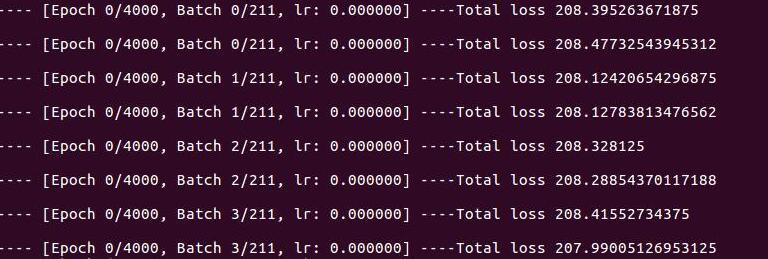pytorch DistributedDataParallel 多卡训练结果变差的解决方案
使用DDP要给dataloader传入sampler参数(torch.utils.data.distributed.DistributedSampler(dataset, num_replicas=None, rank=None, shuffle=True, seed=0, drop_last=False)) 。 默认shuffle=True,但按照pytorch DistributedSampler的实现:
def __iter__(self) -> Iterator[T_co]:
if self.shuffle:
# deterministically shuffle based on epoch and seed
g = torch.Generator()
g.manual_seed(self.seed + self.epoch)
indices = torch.randperm(len(self.dataset), generator=g).tolist() # type: ignore
else:
indices = list(range(len(self.dataset))) # type: ignore
产生随机indix的种子是和当前的epoch有关,所以需要在训练的时候手动set epoch的值来实现真正的shuffle:
for epoch in range(start_epoch, n_epochs):
if is_distributed:
sampler.set_epoch(epoch)
train(loader)
DDP 增大batchsize 效果变差的问题
large batchsize:
理论上的优点:
数据中的噪声影响可能会变小,可能容易接近最优点;
缺点和问题:
降低了梯度的variance;(理论上,对于凸优化问题,低的梯度variance可以得到更好的优化效果; 但是实际上Keskar et al验证了增大batchsize会导致差的泛化能力);
对于非凸优化问题,损失函数包含多个局部最优点,小的batchsize有噪声的干扰可能容易跳出局部最优点,而大的batchsize有可能停在局部最优点跳不出来。
解决方法:增大learning_rate,但是可能出现问题,在训练开始就用很大的learning_rate 可能导致模型不收敛 (https://arxiv.org/abs/1609.04836)
使用warming up (https://arxiv.org/abs/1706.02677)
warmup在训练初期就用很大的learning_rate可能会导致训练不收敛的问题,warmup的思想是在训练初期用小的学习率,随着训练慢慢变大学习率,直到base learning_rate,再使用其他decay(CosineAnnealingLR)的方式训练.
# copy from https://github.com/ildoonet/pytorch-gradual-warmup-lr/blob/master/warmup_scheduler/scheduler.py
from torch.optim.lr_scheduler import _LRScheduler
from torch.optim.lr_scheduler import ReduceLROnPlateau
class GradualWarmupScheduler(_LRScheduler):
""" Gradually warm-up(increasing) learning rate in optimizer.
Proposed in 'Accurate, Large Minibatch SGD: Training ImageNet in 1 Hour'.
Args:
optimizer (Optimizer): Wrapped optimizer.
multiplier: target learning rate = base lr * multiplier if multiplier > 1.0. if multiplier = 1.0, lr starts from 0 and ends up with the base_lr.
total_epoch: target learning rate is reached at total_epoch, gradually
after_scheduler: after target_epoch, use this scheduler(eg. ReduceLROnPlateau)
"""
def __init__(self, optimizer, multiplier, total_epoch, after_scheduler=None):
self.multiplier = multiplier
if self.multiplier < 1.:
raise ValueError('multiplier should be greater thant or equal to 1.')
self.total_epoch = total_epoch
self.after_scheduler = after_scheduler
self.finished = False
super(GradualWarmupScheduler, self).__init__(optimizer)
def get_lr(self):
if self.last_epoch > self.total_epoch:
if self.after_scheduler:
if not self.finished:
self.after_scheduler.base_lrs = [base_lr * self.multiplier for base_lr in self.base_lrs]
self.finished = True
return self.after_scheduler.get_last_lr()
return [base_lr * self.multiplier for base_lr in self.base_lrs]
if self.multiplier == 1.0:
return [base_lr * (float(self.last_epoch) / self.total_epoch) for base_lr in self.base_lrs]
else:
return [base_lr * ((self.multiplier - 1.) * self.last_epoch / self.total_epoch + 1.) for base_lr in self.base_lrs]
def step_ReduceLROnPlateau(self, metrics, epoch=None):
if epoch is None:
epoch = self.last_epoch + 1
self.last_epoch = epoch if epoch != 0 else 1 # ReduceLROnPlateau is called at the end of epoch, whereas others are called at beginning
if self.last_epoch <= self.total_epoch:
warmup_lr = [base_lr * ((self.multiplier - 1.) * self.last_epoch / self.total_epoch + 1.) for base_lr in self.base_lrs]
for param_group, lr in zip(self.optimizer.param_groups, warmup_lr):
param_group['lr'] = lr
else:
if epoch is None:
self.after_scheduler.step(metrics, None)
else:
self.after_scheduler.step(metrics, epoch - self.total_epoch)
def step(self, epoch=None, metrics=None):
if type(self.after_scheduler) != ReduceLROnPlateau:
if self.finished and self.after_scheduler:
if epoch is None:
self.after_scheduler.step(None)
else:
self.after_scheduler.step(epoch - self.total_epoch)
self._last_lr = self.after_scheduler.get_last_lr()
else:
return super(GradualWarmupScheduler, self).step(epoch)
else:
self.step_ReduceLROnPlateau(metrics, epoch)
分布式多卡训练DistributedDataParallel踩坑
近几天想研究了多卡训练,就花了点时间,本以为会很轻松,可是好多坑,一步一步踏过来,一般分布式训练分为单机多卡与多机多卡两种类型;
主要有两种方式实现:
1、DataParallel: Parameter Server模式,一张卡位reducer,实现也超级简单,一行代码
DataParallel是基于Parameter server的算法,负载不均衡的问题比较严重,有时在模型较大的时候(比如bert-large),reducer的那张卡会多出3-4g的显存占用
2、DistributedDataParallel:官方建议用新的DDP,采用all-reduce算法,本来设计主要是为了多机多卡使用,但是单机上也能用
为什么要分布式训练?
可以用多张卡,总体跑得更快
可以得到更大的 BatchSize
有些分布式会取得更好的效果
主要分为以下几个部分:
单机多卡,DataParallel(最常用,最简单)
单机多卡,DistributedDataParallel(较高级)、多机多卡,DistributedDataParallel(最高级)
如何启动训练
模型保存与读取
注意事项
一、单机多卡(DATAPARALLEL)
from torch.nn import DataParallel
device = torch.device("cuda")
#或者device = torch.device("cuda:0" if True else "cpu")
model = MyModel()
model = model.to(device)
model = DataParallel(model)
#或者model = nn.DataParallel(model,device_ids=[0,1,2,3])
比较简单,只需要加一行代码就行, model = DataParallel(model)
二、多机多卡、单机多卡(DISTRIBUTEDDATAPARALLEL)建议先把注意事项看完在修改代码,防止出现莫名的bug,修改训练代码如下:
其中opt.local_rank要在代码前面解析这个参数,可以去后面看我写的注意事项;
from torch.utils.data.distributed import DistributedSampler
import torch.distributed as dist
import torch
# Initialize Process Group
dist_backend = 'nccl'
print('args.local_rank: ', opt.local_rank)
torch.cuda.set_device(opt.local_rank)
dist.init_process_group(backend=dist_backend)
model = yourModel()#自己的模型
if torch.cuda.device_count() > 1:
print("Let's use", torch.cuda.device_count(), "GPUs!")
# 5) 封装
# model = torch.nn.parallel.DistributedDataParallel(model,
# device_ids=[opt.local_rank],
# output_device=opt.local_rank)
model = torch.nn.parallel.DistributedDataParallel(model.cuda(), device_ids=[opt.local_rank])
device = torch.device(opt.local_rank)
model.to(device)
dataset = ListDataset(train_path, augment=True, multiscale=opt.multiscale_training, img_size=opt.img_size, normalized_labels=True)#自己的读取数据的代码
world_size = torch.cuda.device_count()
datasampler = DistributedSampler(dataset, num_replicas=dist.get_world_size(), rank=opt.local_rank)
dataloader = torch.utils.data.DataLoader(
dataset,
batch_size=opt.batch_size,
shuffle=False,
num_workers=opt.n_cpu,
pin_memory=True,
collate_fn=dataset.collate_fn,
sampler=datasampler
)#在原始读取数据中加sampler参数就行
.....
训练过程中,数据转cuda
imgs = imgs.to(device)
targets = targets.to(device)
三、如何启动训练
1、DataParallel方式
正常训练即可,即
python3 train.py
2、DistributedDataParallel方式
需要通过torch.distributed.launch来启动,一般是单节点,
CUDA_VISIBLE_DEVICES=0,1 python3 -m torch.distributed.launch --nproc_per_node=2 train.py
其中CUDA_VISIBLE_DEVICES 设置用的显卡编号,--nproc_pre_node 每个节点的显卡数量,一般有几个显卡就用几个显卡
多节点
python3 -m torch.distributed.launch --nproc_per_node=NUM_GPUS_YOU_HAVE --nnodes=2 --node_rank=0
#两个节点,在0号节点
要是训练成功,就会打印出几个信息,有几个卡就打印几个信息,如下图所示:

以下a、b是对应的,用a保存,就用a方法加载
1、保存
a、只保存参数
torch.save(model.module.state_dict(), path)
b、保存参数与网络
torch.save(model.module,path)
2、加载
a、多卡加载模型预训练;
model = Yourmodel()
if opt.pretrained_weights:
if opt.pretrained_weights.endswith(".pth"):
model.load_state_dict(torch.load(opt.pretrained_weights))
else:
model.load_darknet_weights(opt.pretrained_weights)
单卡加载模型,需要加载模型时指定主卡读模型,而且这个'cuda:0',是看你训练的模型是0还是1(否则就会出错RuntimeError: Attempting to deserialize object on CUDA device 1 but torch.cuda.device_count() is 1. Please use torch.load with map_location to map your storages to an existing device),可以根据自己的更改:
model = Yourmodel()
if opt.pretrained_weights:
if opt.pretrained_weights.endswith(".pth"):
model.load_state_dict(torch.load(opt.pretrained_weights,map_location="cuda:0"))
else:
model.load_darknet_weights(opt.pretrained_weights)
b、单卡加载模型;
同样也要指定读取模型的卡。
model = torch.load(opt.weights_path, map_location="cuda:0")
多卡加载预训练模型,以b这种方式还没跑通。
五、注意事项1、model后面添加module
获取到网络模型后,使用并行方法,并将网络模型和参数移到GPU上。注意,若需要修改网络模块或者获得模型的某个参数,一定要在model后面加上.module,否则会报错,比如:
model.img_size 要改成 model.module.img_size
2、.cuda或者.to(device)等问题
device是自己设置,如果.cuda出错,就要化成相应的device
model(如:model.to(device))
input(通常需要使用Variable包装,如:input = Variable(input).to(device))
target(通常需要使用Variable包装
nn.CrossEntropyLoss()(如:criterion = nn.CrossEntropyLoss().to(device))
3、args.local_rank的参数
通过torch.distributed.launch来启动训练,torch.distributed.launch 会给模型分配一个args.local_rank的参数,所以在训练代码中要解析这个参数,也可以通过torch.distributed.get_rank()获取进程id。
parser.add_argument("--local_rank", type=int, default=-1, help="number of cpu threads to use during batch generation")
以上为个人经验,希望能给大家一个参考,也希望大家多多支持软件开发网。